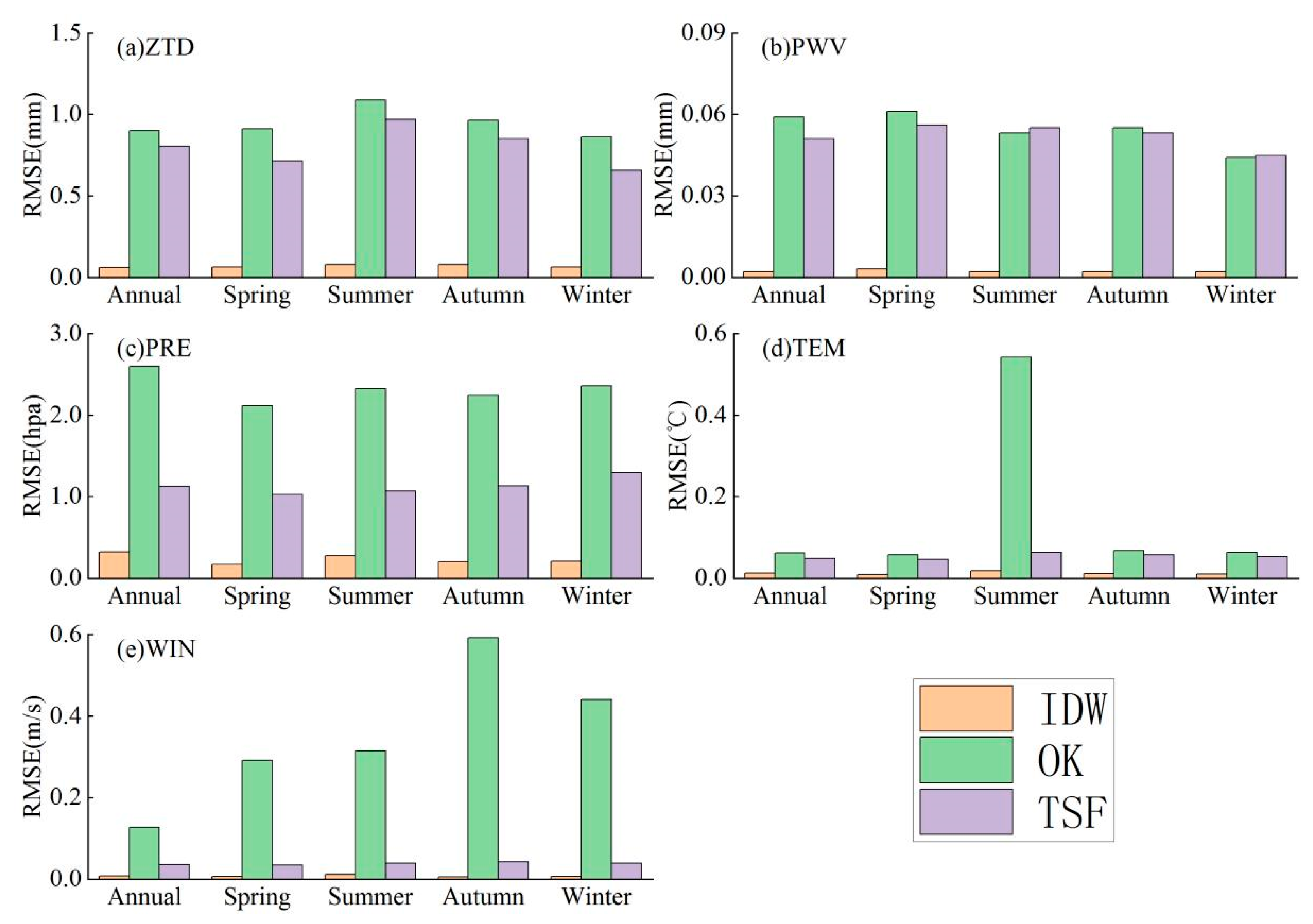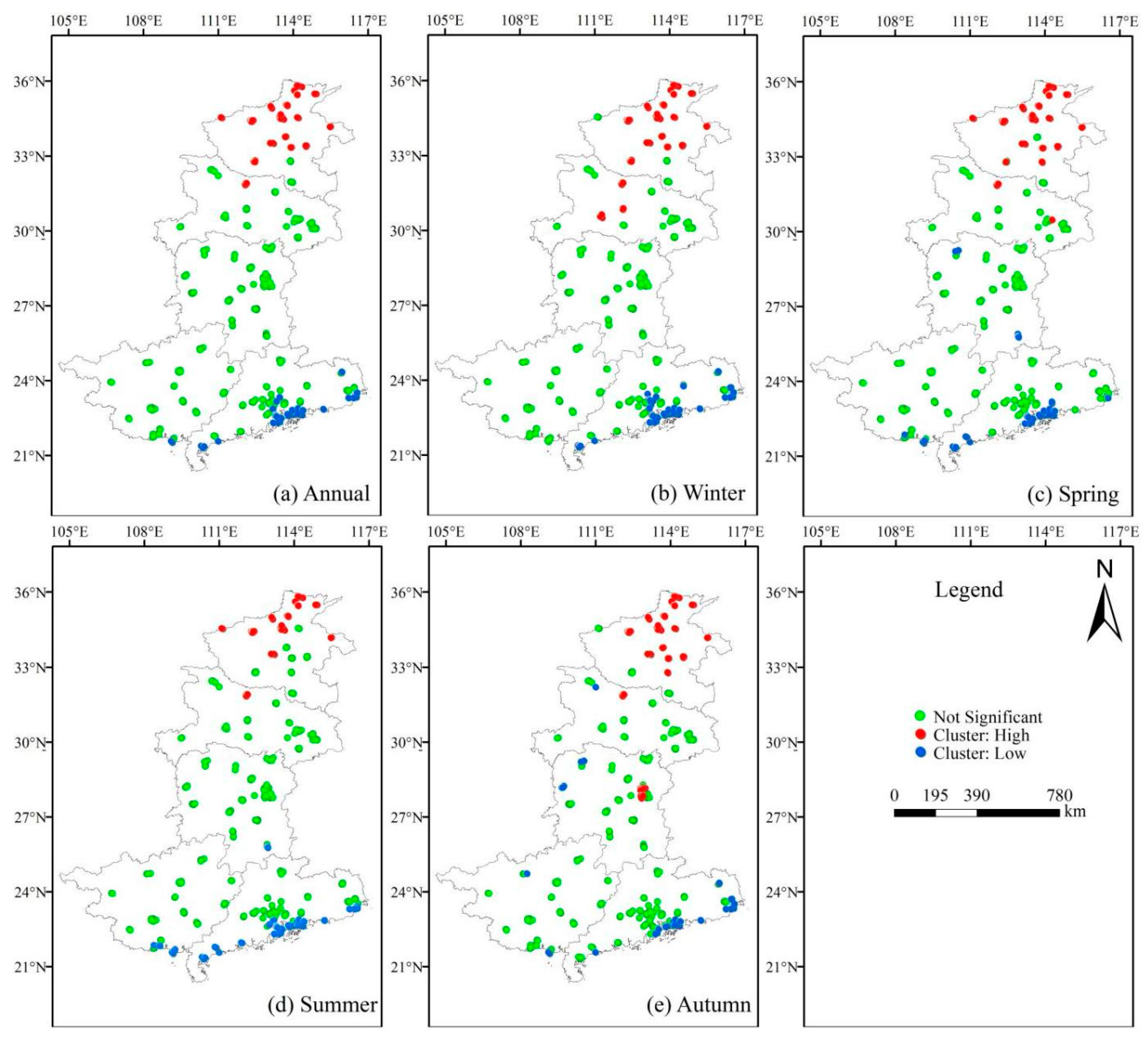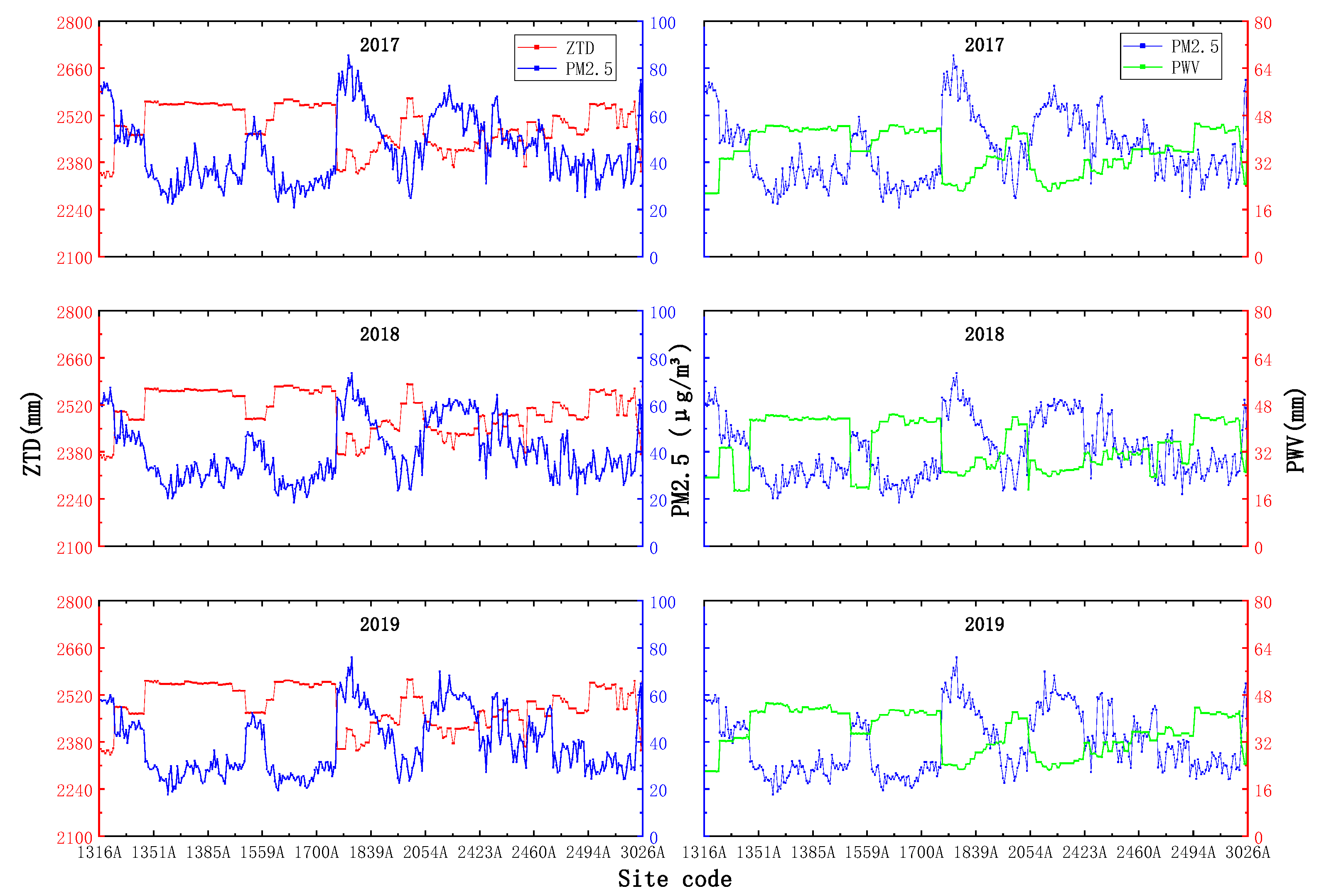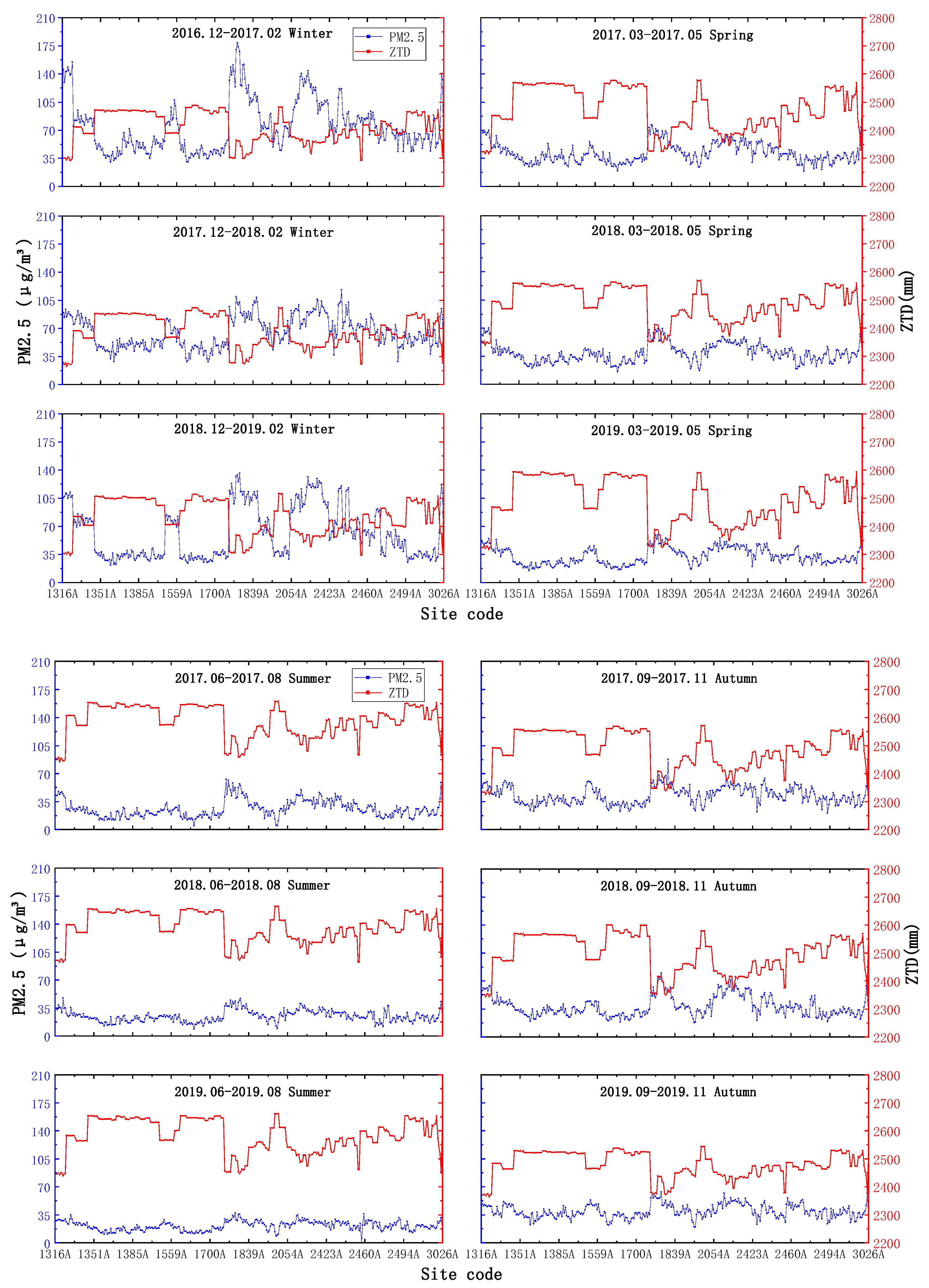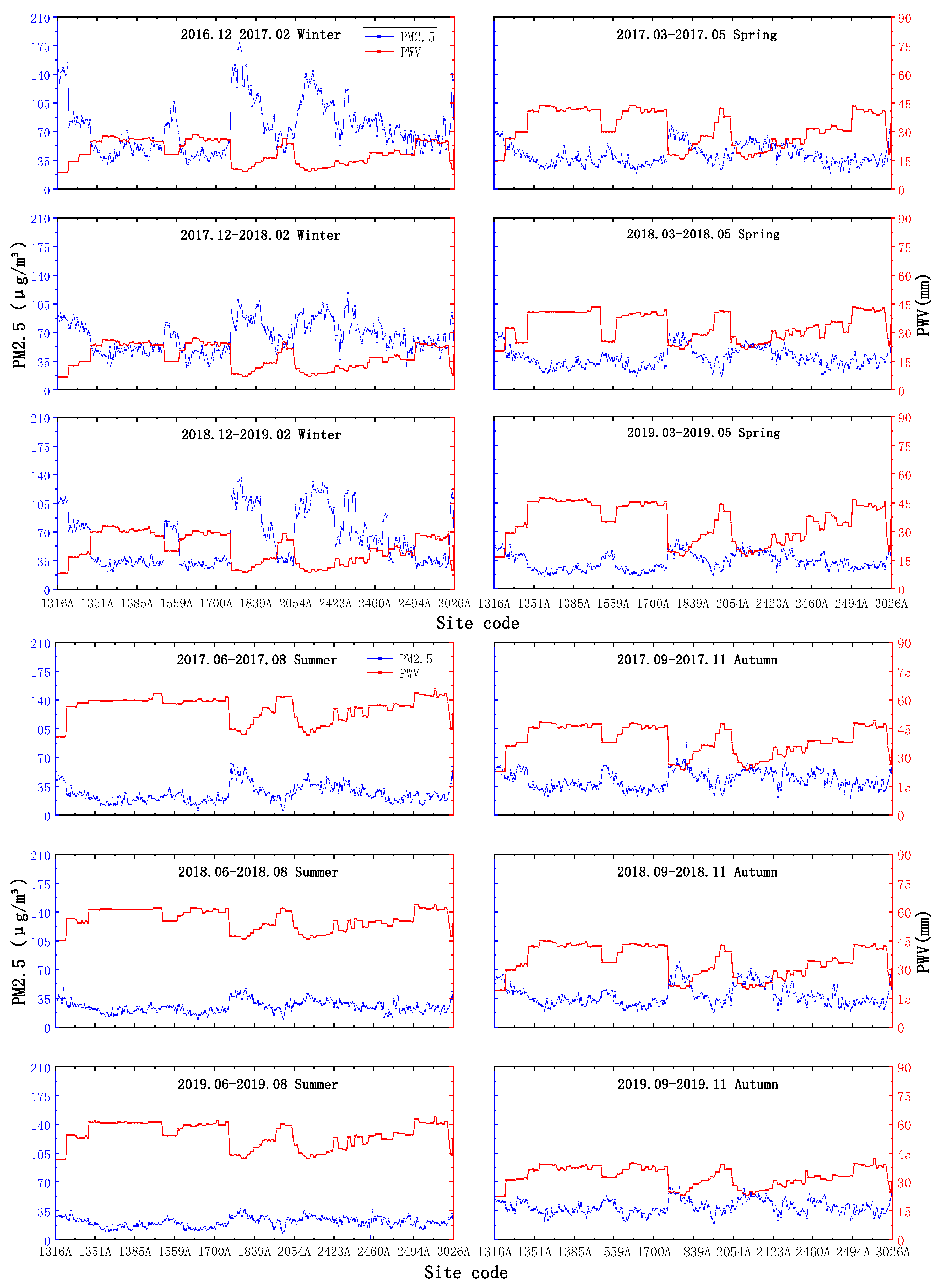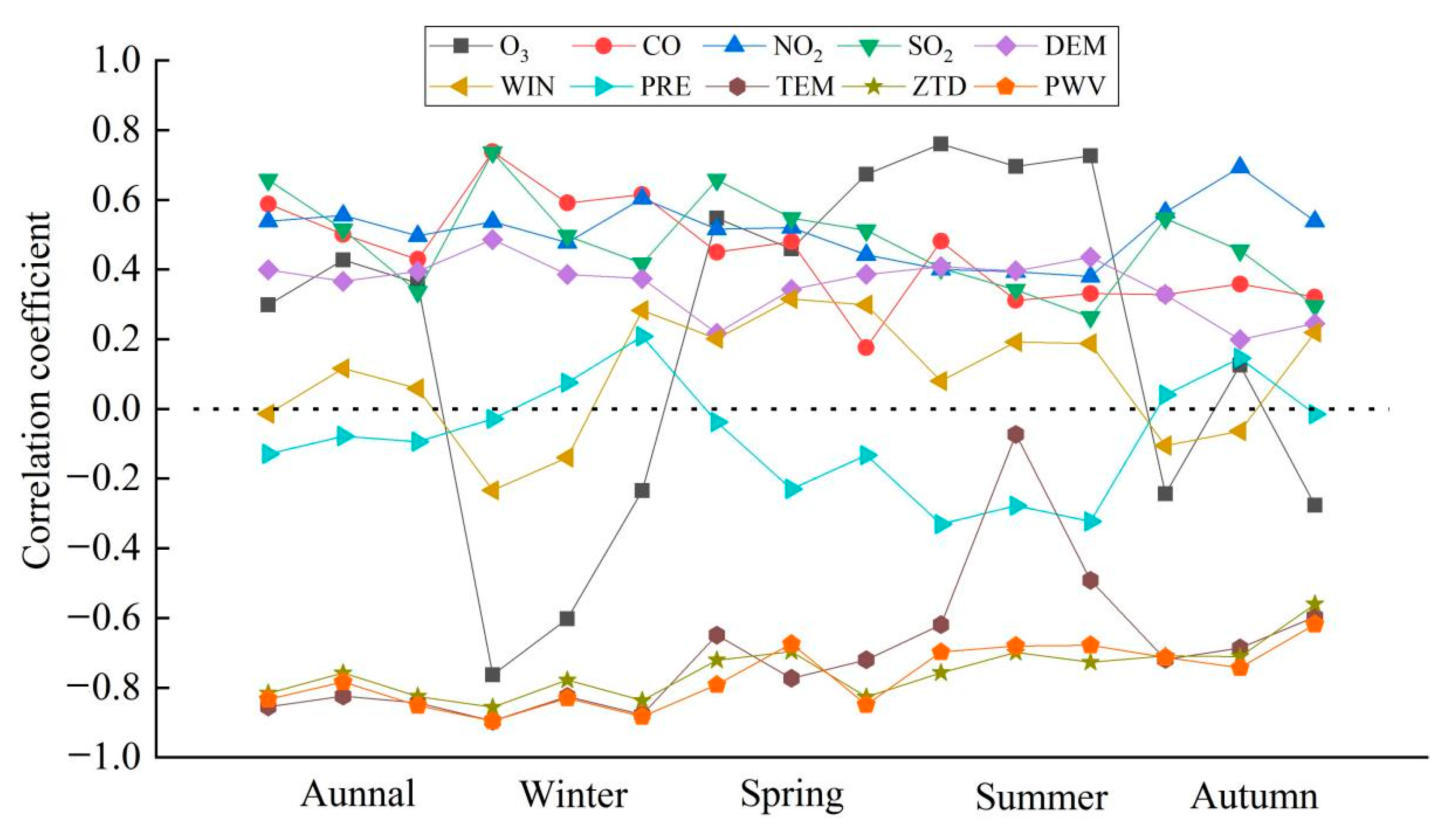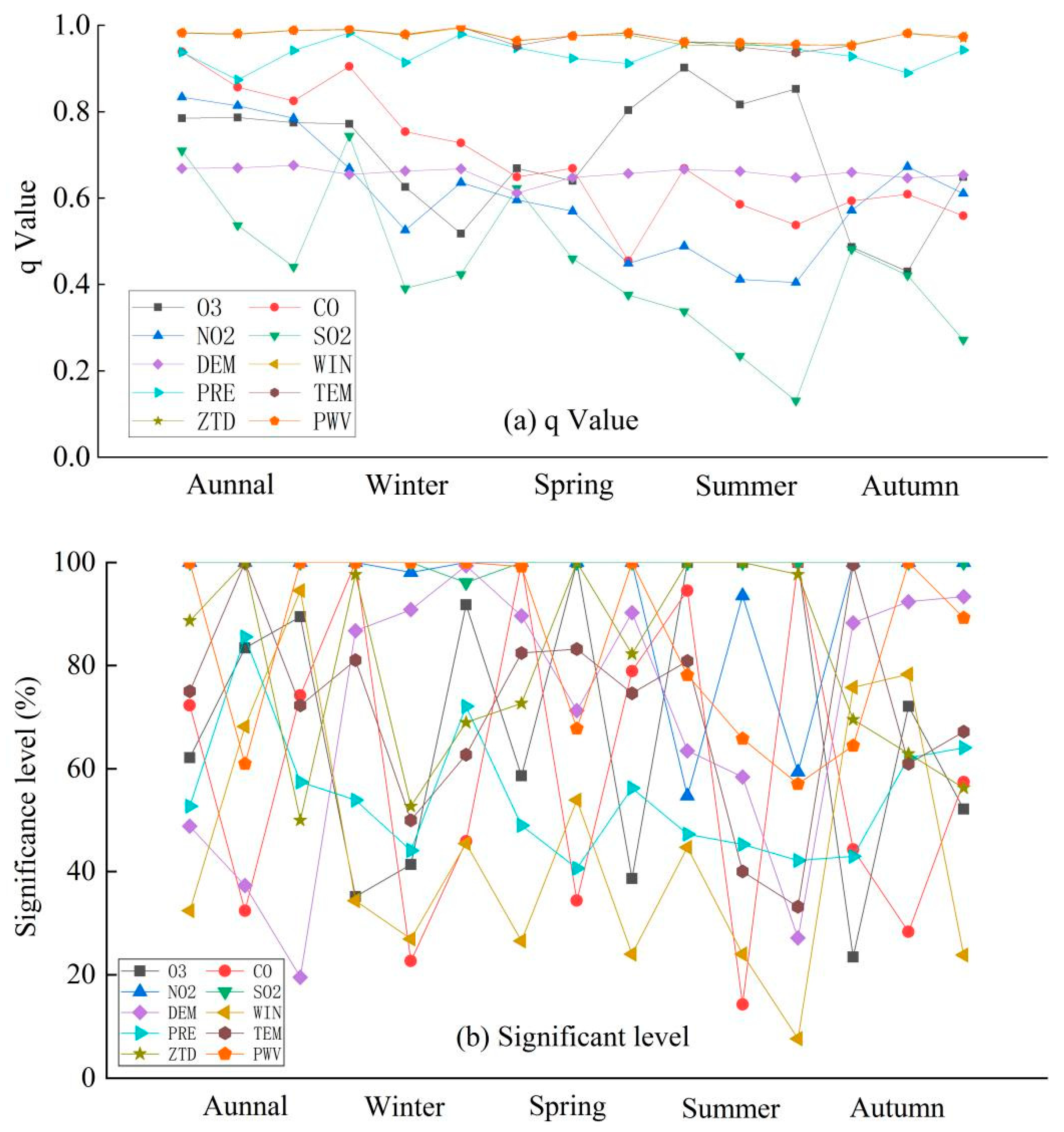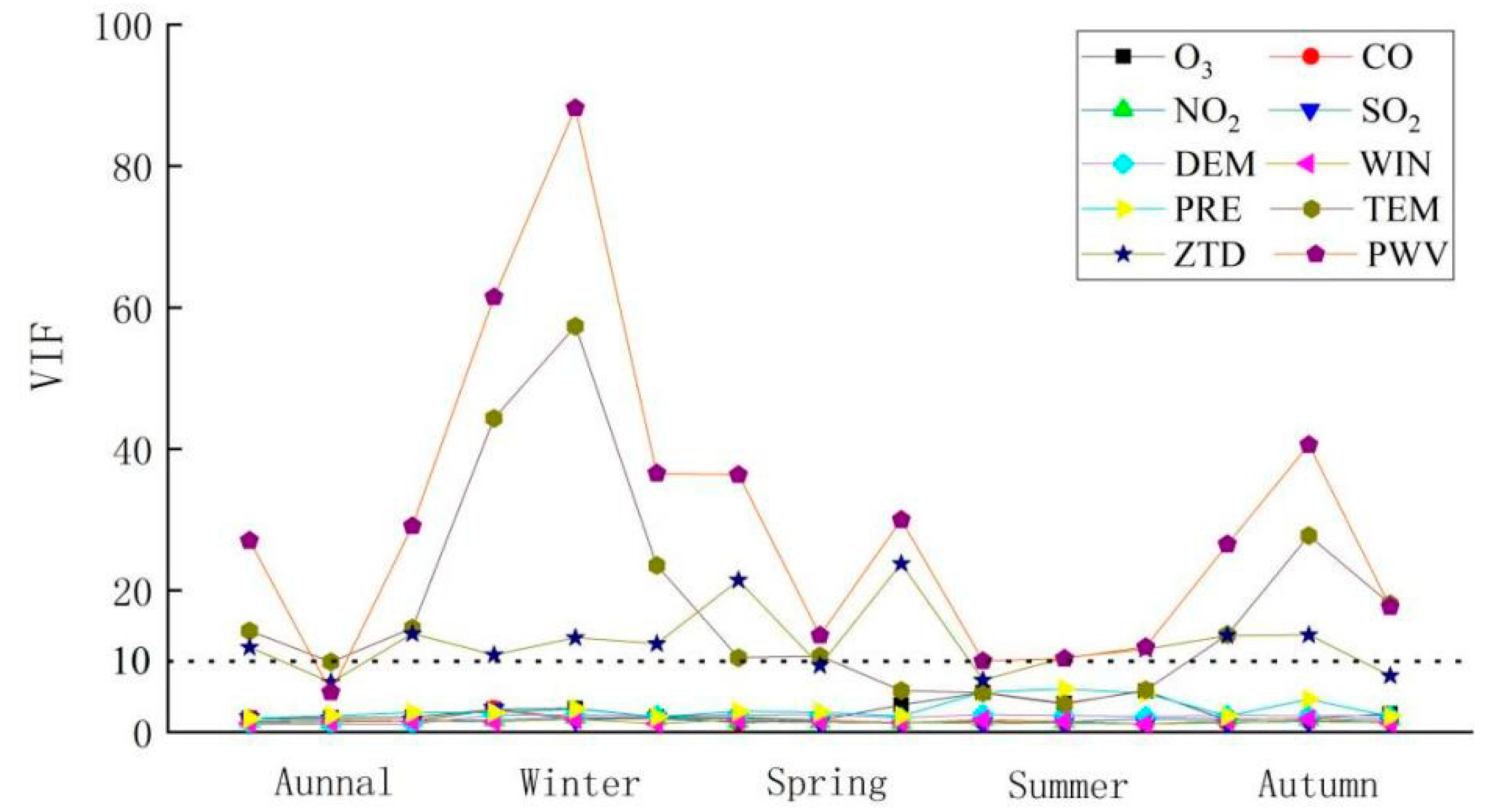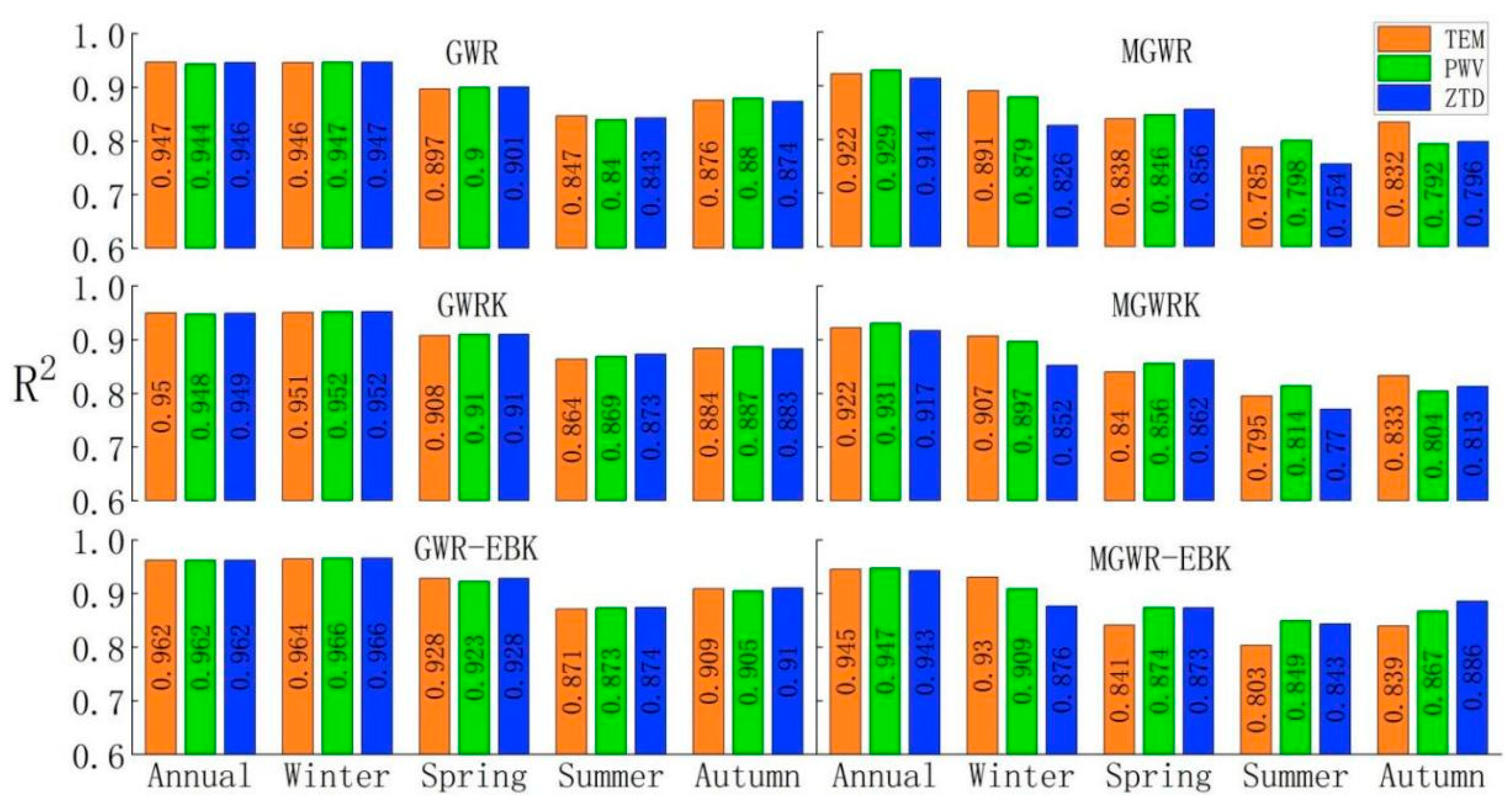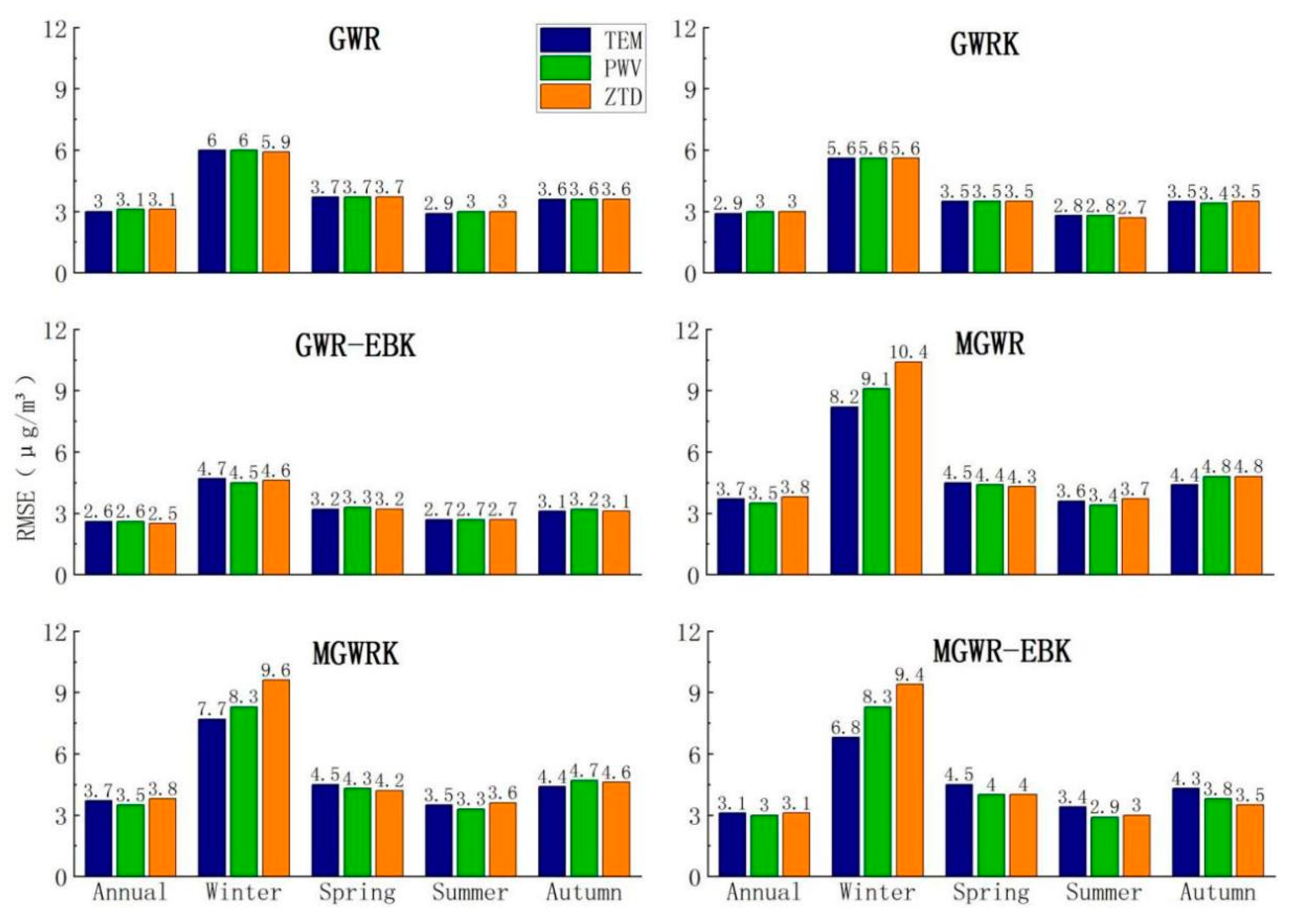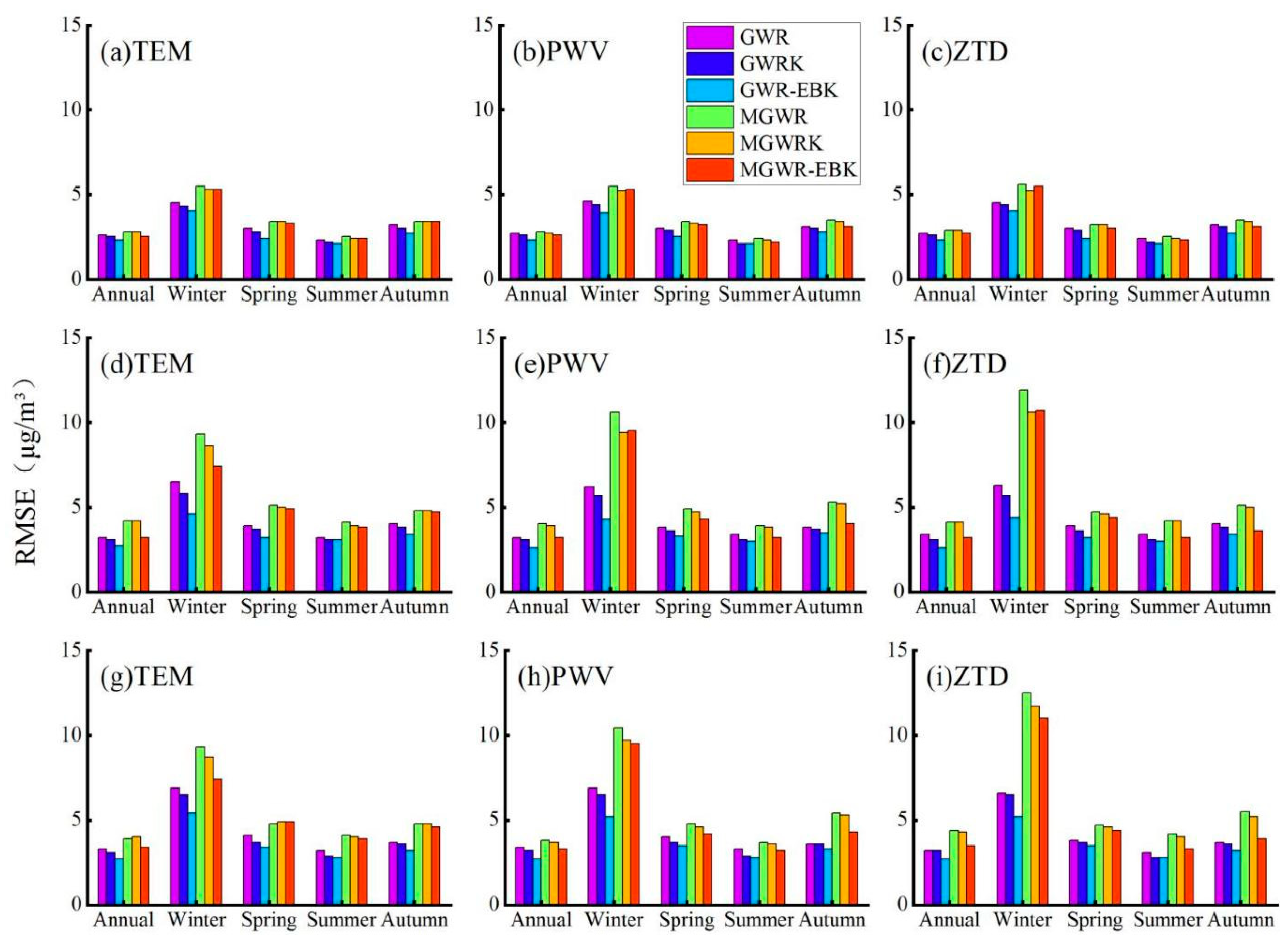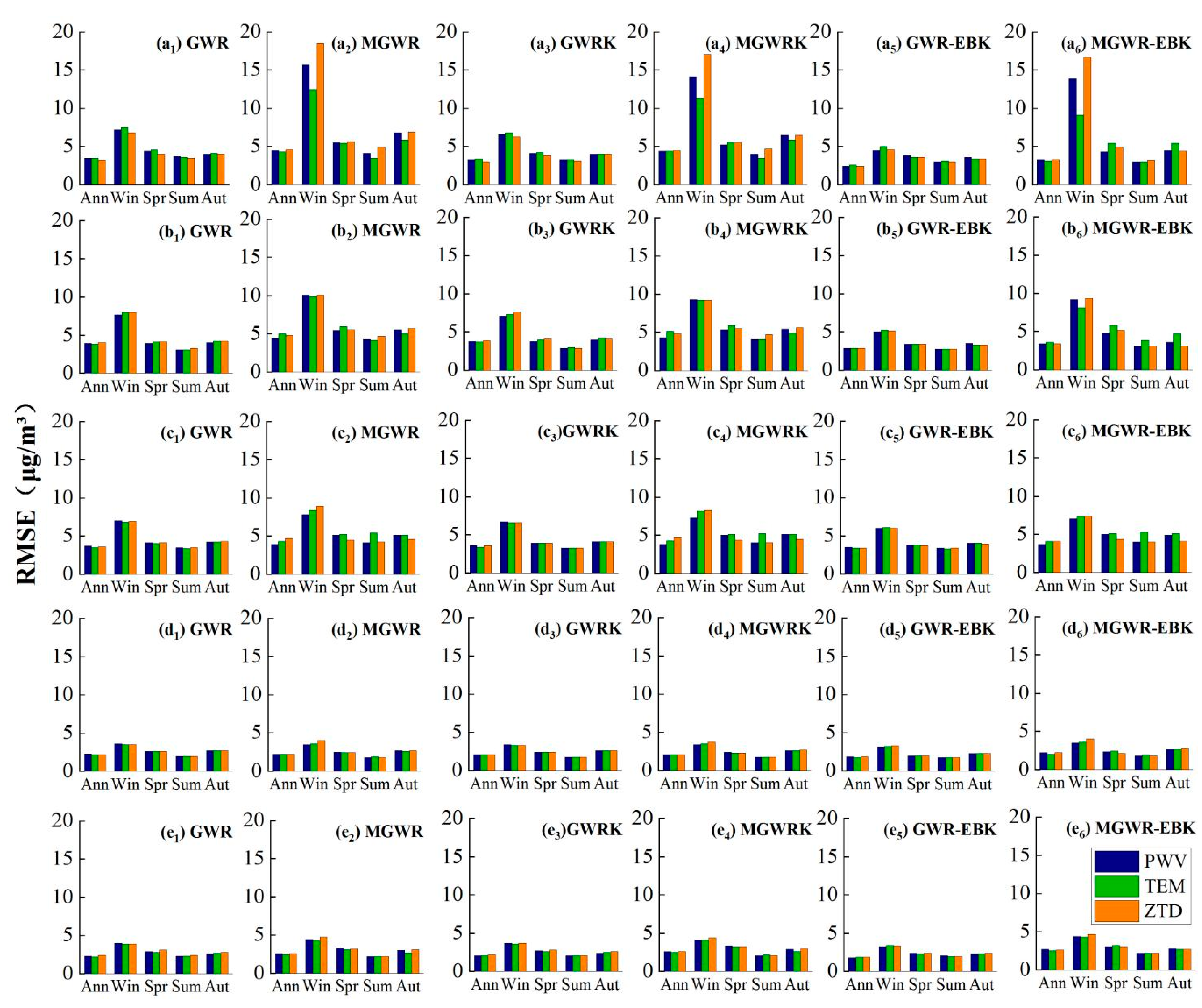1. Introduction
PM
2.5 refers to fine particulate matter with a diameter of less than or equal to 2.5 μm existing in the ambient air; this matter has the characteristics of a long suspension time in the air, a long transportation distance, strong activity, and easy absorption of toxic and harmful substances; especially high PM
2.5 concentrations cause occurrences of hazy weather [
1,
2,
3]. In recent years, the environmental pollution caused by PM
2.5 has gradually attracted attention. Since 2012, China has built a large number of ground-based PM
2.5 stations nationwide. However, China is a vast country, and the number of ground-based PM
2.5 stations is still scarce, and therefore they cannot accurately explain all the temporal and spatial characteristics of PM
2.5, thus limiting the application of PM
2.5 data in a variety of practical applications. Therefore, it is necessary to further study how to obtain continuous and accurate regional PM
2.5 distributions on different temporal and spatial scales and how to use limited station-derived data to conduct high-precision regional PM
2.5 temporal and spatial interpolations, and these applications have become a research hotspot.
China is a vast country, and many scholars have tried to explore the variation patterns of PM
2.5 in different regions of China, such as North China [
4], the Yangtze River Economic Zone [
5], the Pearl River Delta [
6], Heilongjiang Province [
7], and the Beijing–Tianjin–Hebei region [
8,
9]. When exploring the changing characteristics of PM
2.5, many scholars have tried to use different PM
2.5-related variables to combine analyses to improve the accuracy of PM
2.5 simulations. The impact of the population density, GDP and other social or economic activities on PM
2.5 concentrations in Chinese cities with significant spatial heterogeneity was explored by Gu et al. [
10]; Tai et al. used 11-year (1998–2008) PM
2.5 observation records in the United States to explore the correlations between PM
2.5 and meteorological variables, and the results showed that the daily variations in meteorological variables described by MLR can explain up to 50% of PM
2.5 changes [
11]; Ye et al. used Fairbanks standard air pollutants (NO
2, SO
2, CO, O
3, PM
2.5 and PM
10) and meteorological parameter (temperature, wind speed and relative humidity) observations, temporal changes and related analyses, and all pollutants showed obvious seasonal trends under the influence of climatology, topography and human activities [
12].
With the development of GNSS technology, the global navigation satellite system’s (GNSS) zenith tropospheric delay (ZTD), zenith wet delay (ZWD) and precipitable water vapor (PWV) data are able to reflect certain atmospheric water vapor information and can also reflect changes in meteorological conditions [
13,
14]. Therefore, some scholars have begun to introduce GNSS data into the PM
2.5 research field; for example, Wen et al. [
15] explored the correlation between PM
2.5 and ZWD in Baoding, Hebei, China, and found that the correlation coefficient between the daily average PM
2.5 and ZWD was mainly greater than 0.4 in autumn and winter in this region, while the correlation coefficient between the hourly average PM
2.5 and ZWD was mainly greater than 0.3. Guo et al. [
16] took the GNSS data from Beijing Fangshan Station (BJFS) as an example to analyze the correlations among GNSS-derived PWV and ZTD and PM
2.5 hourly sequences. The experimental results showed that it is effective to consider using GNSS-derived ZTD to assist in haze monitoring.
Due to the continuous development and improvement of spatial fitting and interpolation models, some scholars have used geographically weighted regression (GWR) [
17] to simulate PM
2.5 in space and have achieved good results. Zhou et al. [
18] established a model based on PM
2.5 data from 283 prefecture-level cities in China combined with the random regressed effects of the population, economy, and technology, and used geographically weighted regression methods to evaluate the impacts of different factors on haze pollution in different regions. Wang et al. [
19] used the GWR method to explore the strengths and directions of the relationships among various factors in Chinese cities and PM
2.5, established a comprehensive explanatory framework consisting of 18 determinants covering natural and social conditions, and determined three major categories of economic factors and urban characteristics. Among all natural variables, elevation has a statistically significant impact on PM
2.5 in 95.60% of cities, and is negatively correlated with PM
2.5 in 99.63% of cities. The effect of elevation is gradually weakened from eastern China to western China; Zou et al. [
20] compared the simulation effects of two land use regression (LUR) and GWR models on PM
2.5 concentrations in California. The results showed that both the GWR and LUR models were able to estimate the PM
2.5 concentrations and map the spatial distribution in the study area. Jiang et al. [
21] introduced a variety of auxiliary variables, such as meteorological and geographic factors, into the GWR model to establish a four-season GWR model of PM
2.5 in the Yangtze River Delta. Hajilooe et al. [
22] evaluated the relationship between the meteorological variables (humidity, pressure, temperature, precipitation and wind speed) associated with the PM
2.5 concentration in Tehran and environmental parameters (normalized vegetation index and surface temperature from MODIS satellite data) using GWR to evaluate the impacts of key parameters on PM
2.5 concentrations in winter and summer.
Due to the strong spatial and temporal heterogeneity of PM
2.5, most scholars have begun to study GWR models that are more applicable to PM
2.5. Yang et al. [
23] analyzed regional PM
2.5 spatial variation relationships in China by developing a modified GWR model using meteorological, topographical and emission factors observed in 2015. Rui et al. [
24] analyzed the spatial distribution of PM
2.5 concentrations in the Pearl River Delta region of China using an enhanced GWR model by introducing geodetector analysis and principal component analysis (PCA) to enhance the GWR model. Zhai et al. [
25] developed a best subset regression (BSR)-augmented PCA-GWR modeling approach to estimate PM
2.5 concentrations by fully considering the contributions of all potential variables simultaneously, and conducted a one-year experiment comparing the performance of PCA-GWR with that of conventional GWR in the Beijing–Tianjin–Hebei region. The results showed that the PCA-GWR model outperformed the conventional GWR model.
Most of the abovementioned studies dealt with PM
2.5 and related variables when modeling the experimental data, but did not consider the effect of model residuals. Some scholars introduced the kriging interpolation method to interpolate the GWR residuals for the purpose of correcting the fitted values of the GWR model for the spatial autocorrelation of the residuals after fitting the GWR model, deriving the GWRK model from this; however, this model has been mostly applied to geological field-related research [
26,
27,
28]. On the basis of GWRK, Kumari et al. [
29] proposed a stratified, geographically weighted regression residual kriging (s-GWRK) method and applied it to complex-terrain rainfall interpolations with good results; however, few scholars have applied this type of GWRK model to study PM
2.5 spatial interpolations.
For the kriging interpolation method, empirical Bayesian kriging (EBK) has been proposed based on this method. Empirical Bayesian kriging differs from other kriging methods in that it accounts for the introduced error by estimating the underlying semivariance function, which has the advantage of predicting standard errors more accurately than other kriging methods, and can accurately predict data that are generally unstable in degree [
30,
31].
Some scholars have improved the GWR method from the spatial-scale perspective, and the model that is most representative of these improvements is the multiscale geographically weighted regression (MGWR) model, which is more flexible than the GWR model. The model allows different processes to work on different spatial scales [
32], and the MGWR model has been applied to spatial simulations of PM
2.5 by some; Fan et al. [
33] used the MGWR model to simulate the spatial and temporal patterns of PM
2.5 and its associated influencing factors during the outbreak of new crown pneumonia in China. Yan et al. [
34] simulated the spatial and temporal distribution characteristics and driving forces of PM
2.5 in three major urban agglomerations in the Yangtze River Economic Zone of China using the MGWR model, and found that the total precipitation, wind speed and green coverage had the most significant effects on the PM
2.5 distribution.
Although both types of models, GWR and MGWR, have performed well in previous spatial studies of PM2.5, as described above, strong spatial heterogeneity and spatial nonstationarity exists in PM2.5 distributions, and it is difficult for the above-mentioned models to handle or simultaneously handle these two PM2.5 distribution characteristics. Therefore, to improve the interpolation of PM2.5 concentration values, we compare the changes induced by the differences in each time scale and spatial scale to the model interpolation effect, fully consider the variations in GNSS-derived ZTD and PWV, and two models, the kriging and empirical Bayesian kriging models, are introduced to eliminate the effect of residual spatial correlations on the fitting of the GWR and MGWR models, thus improving the interpolation accuracy.
5. Results and Analysis
5.1. Overall Model Effect
Six types of models (GWR, GWRK, GWR-EBK, MGWR, MGWRK and MGWR-EBK) were analyzed on annual and seasonal scales for each of the three combinations of variables. To quantitatively compare the overall simulation effect of each model at each scale, the decidability factor
R2 is used as the basis for comparison, and is calculated as shown in Equation:
where
is the real value,
is the interpolated result, and
is the mean of the real values. The value of
R2 is between 0 and 1, and the larger the value is, the better the model fitting effect is. The
R2 value of each model for each scale is listed in
Figure 11.
The information in
Figure 11 shows that on an annual average scale, all six models can reach
R2 values above 0.9 using the three variable schemes for modeling, and show good fitting effects. Among the six models analyzed using variables such as temperature, the lowest
R2 values are obtained for the two models MGWR and MGWRK, with values of 0.922 recorded, and the highest value is obtained for the GWR-EBK model, with an
R2 value of 0.962 recorded. The lowest
R2 when modeling with variables such as PWV is obtained for MGWR at 0.929. This lowest value is slightly higher than the lowest
R2 value of the model obtained when considering variables such as temperature, while the highest
R2 value is 0.962 for the GWR-EBK model, which is the same as the highest value obtained when considering variables such as temperature. When modeling with variables such as ZTD, the lowest value is 0.914 for the MGWR model, and the highest value is still 0.962 for the GWR-EBK model; therefore, on the annual average scale, the best overall model fit is found for the GWR-EBK model, and the worst is the MGWR model.
From the analysis of the seasonal average scale, the GWR-EBK model effect reaches 0.964 in winter when the six models consider variables such as temperature due to the annual average scale of 0.962, while the fitting effect of MGWR drops to 0.891. When considering variables such as PWV, the fit of the GWR-EBK model improves again compared to the combination of temperature variables, reaching 0.966, while the MGWR model decreases again to 0.879. When considering variables such as ZTD, the R2 values of the MGWR-class models all drop below 0.9, while the GWR-EBK model fit is the same as that obtained when considering PWV-like variables.
The R2 values of all six models decrease in spring compared to winter, and the GWR-EBK model still performs best in spring among all six models. The effect of the combination of both variables considering temperature and ZTD outperformed the effect of the combination of variables considering PWV, reaching 0.928. In contrast, the MGWR model with a combination of temperature-class variables had the worst simulation fit, with an R2 of 0.838. The R2 values of 0.846 and 0.856 obtained when considering the combination of two types of variables, PWV and ZTD, respectively, are better than the modeling effect obtained via the combination of temperature variables.
In summer, when PM2.5 values change to the lowest values measured among the four seasons, the R2 values of the six models continue to fall, all to below 0.9, with the highest R2 value of 0.874 obtained for the GWR-EBK model when considering the combination of ZTD variables, and the lowest R2 value of 0.754 obtained for the MGWR model.
In autumn, appropriate increases in R2 are observed for the six models. Among them, the GWR-EBK model has an R2 value higher than 0.9 for all three variable combinations modeled, with the highest value being modeled using the ZTD variable combination (0.910), and the lowest R2 value of 0.792 obtained for the MGWR model built using the PWV variable combination.
In summary, in terms of the overall model goodness of fit, the model effects are annual > winter > spring > autumn > summer, the best performance of the goodness of fit is obtained with the GWR-EBK model, and the worst performance is obtained with the MGWR model. Compared with the results obtained with single models such as GWR and MGWR, the quadratic treatment of single-model-regression residuals using interpolation methods such as kriging and empirical Bayesian kriging can effectively improve the fit of the original data. From the choice of variable combinations, the highest R2 value is 0.962 for all three variable combinations at the annual average scale, and the effect of considering the combination of ZTD variables is better than the effects of considering the other two types of variable combinations, temperature and PWV, at the seasonal average scale. The possible reason for the change in the model R2 values with the changing seasons is that when the PM2.5 value is lower in a given season, the decrease ratio of the sum of squares of the difference between the true value and the mean value may be greater than the decrease ratio of the sum of squares of the residuals, so the increase in the sum of squares of the residuals divided by the sum of squares of the difference between the true value and the mean value leads to a decrease in the R2 value.
We calculated and summarized the RMSEs of the interpolation results obtained from the various constructed models; RMSE is a good indicator for testing the accuracy of an interpolation and can be used to measure the deviation between the interpolation results and the true values. The RMSE results are shown in
Figure 12.
As seen from the results in
Figure 12, the GWR-EBK model with the best goodness of interpolation on the annual average scale also has the smallest RMSE, but unlike the goodness of interpolation results, the GWR-EBK model has an equal goodness of interpolation after considering three different combinations of variables for modeling, while in the RMSE results, the combination of ZTD variables considered for modeling results in a smaller RMSE with better results.
On the seasonal average scale, the RMSEs of the models also show a larger phenomenon in winter due to the larger PM2.5 values, with the lowest value obtained for the GWR-EBK model built with the combination of PWV variables (an RMSE of 4.5 μg/m3) and the highest obtained for the MGWR model built with the combination of ZTD variables (an RMSE of 10.4 μg/m3). The RMSE of the GWR-EBK model built by the combination of ZTD variables and temperature variables was optimal and equal in spring and autumn, with RMSEs of 3.2 μg/m3 and 3.1 μg/m3 obtained, respectively; the PM2.5 values were the lowest in summer, so the RMSEs of the model interpolation were also the lowest in this season; the RMSE of the GWR-EBK model obtained using the combination of three types of variables was the lowest and was equal to 2.7 μg/m3.
The model effects used for the comparison of the RMSE results are quite similar to those used for the comparison of the goodness of interpolation results. The GWR-EBK model performs the best, and at the annual average scale, the combined results of the two comparisons show that the GWR-EBK model constructed by considering the combination of ZTD variables works best. At the seasonal average scale, the GWR-EBK model constructed by considering the combination of PWV variables performed best in winter, while the GWR-EBK model constructed by the combination of ZTD variables had the highest accuracy in spring, summer and autumn.
5.2. Local Model Effect
PM2.5 is a variable with strong spatial and temporal heterogeneity. To further analyze the spatial effect of the model interpolation for PM2.5 in depth, the model effect is further explored from two perspectives: the DEM-derived elevation and the province.
5.2.1. Elevation as a Classification Criterion
The 340 PM2.5 ground stations in the five south-central provinces of China were roughly divided into three categories based on their DEM-derived elevations and the number of stations, with 117 stations below 35 m, 111 stations between 35 and 90 m, and 112 stations greater than 90 m.
The accuracy of the model interpolation for each local elevation interval was quantified using RMSE, and the obtained precisions were compared.
From the annual average data, it can be seen that with an increase in the DEM elevation, the overall accuracy of the model interpolation gradually decreases; for the two elevation intervals less than 35 m (
Figure 13a–c) and more than 90 m (
Figure 13g–i), the GWR-EBK model built from the combination of the three variables has the highest interpolation accuracies, at 2.3 μg/m
3 and 2.7 μg/m
3, respectively. In the interval of 35–90 m (
Figure 13d–f), the accuracy of the GWR-EBK model built by the combination of two variables, PWV and ZTD, is better than that of the model constructed by the combination of temperature variables.
The RMSE statistics of the model considered for each elevation interval in winter show that the accuracy of the GWR-EBK model established by using the combination of PWV variables is optimal in each elevation interval, showing good generalizability, and combined with the overall accuracy evaluation results above, this result proves that the accuracy of the model is optimal in winter in the five provinces in south-central China, both overall and in different elevation intervals.
From the statistical results obtained in spring, it can be seen that the GWR-EBK model built considering the combination of two types of variables, temperature and ZTD, has the highest interpolation accuracy, with RMSEs of 2.4 μg/m
3 and 3.2 μg/m
3 recorded in the intervals less than 35 m (
Figure 13a,c) and 35–90 m (
Figure 13d,f), respectively, while in the interval greater than 90 m (
Figure 13g,i), the GWR-EBK model built by considering the combination of temperature variables has the highest interpolation accuracy (a value of 3.4 μg/m
3). From the elevation interval effect, it can be seen that although the GWR-EBK model established by considering the combination of temperature variables and ZTD variables in the overall accuracy evaluation of the model in the previous section has an equal RMSE value, after refining the elevation interval, it can be found that the effect of considering the combination of temperature variables (
Figure 13g) is better than the effect of considering the combination of ZTD variables (
Figure 13i) in the interval greater than 90 m.
The model interpolation accuracy results presented in the summer were consistent with those obtained on the annual average scale, and the GWR-EBK model built by the three variable combinations had the highest accuracies of 2.1 μg/m
3 and 2.8 μg/m
3 in the two elevation intervals less than 35 m (
Figure 13a–c) and more than 90 m (
Figure 13g–i), respectively. In the 35–90-m interval, the GWR-EBK model built by the combinations of the PWV (
Figure 13e) and ZTD (
Figure 13f) variables had better accuracy than that of the temperature variable (
Figure 13d) combination constructed models. The accuracy of the model interpolation remained consistent overall, and for each elevation interval during the fall season: i.e., the GWR-EBK model consisting of a combination of two types of variables, temperature and ZTD, was considered to be the best.
5.2.2. Province as a Classification Criterion
The 340 PM
2.5 ground stations were then divided into provinces, and the model effects were discussed in each of the five provinces in the south-central region to explore the model applicability of each province at each scale, including 66 points in Henan province, 48 points in Hubei province, 75 points in Hunan province, 101 points in Guangdong province, and 50 points in Guangxi province. The RMSE results obtained for the six models constructed from the combination of the three variable types at the annual average scale are listed in
Figure 14.
Through
Figure 14, we can see that the model has larger RMSE values in Henan, Hubei and Hunan provinces and smaller RMSE values in Guangdong and Guangxi provinces, which is consistent with the previously obtained PM
2.5 distribution patterns in the five south-central provinces (high in the north and low in the south).
The best results were obtained for the GWR-EBK model constructed by combining two types of variables, PWV and ZTD, in Henan province (
Figure 14a); for the GWR-EBK model constructed by combining three types of variables in Hubei province (
Figure 14b); for the GWR-EBK model constructed by combining two types of variables, temperature and ZTD, in Hunan province (
Figure 14c); for the model constructed by combining temperature variables in Guangdong province (
Figure 14d); for the model constructed by combining PWV variables in Guangxi province (
Figure 14e).
In winter, the GWR-EBK model constructed from the combination of PWV variables had the best applicability in all five provinces, and combined with the results of the previous analysis, this proves that the model has the strongest generalizability during winter in the five south-central provinces.
In two provinces, Hubei (
Figure 14b) and Guangdong (
Figure 14d), in spring, the GWR-EBK models constructed with different combinations of variables were equally applicable; in Henan province (
Figure 14a), the consideration of the combination of both temperature and ZTD variables obtained better results; in Hunan province (
Figure 14c), the best GWR-EBK model was constructed by considering ZTD; in Guangxi province (
Figure 14e), the best GWR-EBK model was constructed by considering the combination of temperature variables.
The models with the best interpolation accuracies for Henan province (
Figure 14a) in summer are of four types: the GWR-EBK and MGWR-EBK models considering PWV, the MGWR-EBK model considering temperature and the GWR-EBK model considering ZTD; combined with the
R2 values of the summer models, these results show that the GWR-EBK model considering ZTD is the best overall. The GWR-EBK model constructed by the combination of three variables in Hubei province (
Figure 14b) has the same effect, and the model with the smallest RMSE in Hunan province (
Figure 14c) also has four categories, while the combination of the summer model
R2 shows that the GWRK model that considers ZTD has the best effect overall. In Guangdong province (
Figure 14d), the RMSEs of various models were not very different, but combined with the magnitudes of the
R2 values, it can be judged that the GWR-EBK model considering ZTD is the next-best model, and the GWR-EBK model considering temperature and ZTD is the best model in Guangxi province (
Figure 14e).
The two types of GWR-EBK models considering temperature and ZTD had the best accuracy performances in Henan (
Figure 14c) and Hubei provinces (
Figure 14b) in autumn, while the GWR-EBK model considering ZTD had the best effect in Hunan province (
Figure 14c), the GWR-EBK model constructed by combining three variables had the best and equal effect in Guangdong province (
Figure 14d), and the two types of GWR-EBK models considering PWV and temperature had the best effects in Guangxi province (
Figure 14e).
6. Discussion
After comparing the interpolation effects of three interpolation methods in obtaining meteorological data and GNSS-derived PWV and ZTD data from PM2.5 ground stations, the results show that the IDW interpolation method has better interpolation effects than the kriging method and the TSF interpolation method for meteorological parameters and GNSS-derived PWV and ZTD data in the five studied central and southern provinces.
By comparing the changes in the spatial distribution map of PM2.5 in the region, it can be seen that the PM2.5 concentration values in the five south-central provinces of China show obvious seasonal variation characteristics of high values in winter and low values in summer, and geographical characteristics of high values in the north and low values in the south, while clustering phenomena mainly occur in Henan and Guangdong provinces, with high clustering in Henan province and low clustering in Guangdong province recorded.
The experiments show that considering GNSS-derived PWV and ZTD data in the construction of a regional PM2.5 model is effective and feasible and is better than the regional model constructed by considering only the atmospheric pollutants, meteorological factors and elevation factors in the annual and seasonal averages in many cases, with better interpolation effects. In the five provinces of south-central China, PWV and ZTD show strong negative correlations with PM2.5 as well as with temperature, showing seasonal characteristics of low values in winter and high values in summer, and geographical characteristics of high values in the south and low values in the north. The significance magnitude in the exploratory regression is divided into atmospheric pollutants > GNSS parameters (ZTD and PWV) > meteorological factors, and the results of the stratified heterogeneity of geodetectors again reflected the significant correlation between GNSS parameters and PM2.5, providing a guide for constructing a regional PM2.5 model when meteorological data are missing and PWV and ZTD data can be used as a substitute.
In constructing a regional model of PM2.5, the interpolation effect of the model changes depending on the choice of variables, the time scale, and the spatial scale. The GWR model has a stronger ability to estimate PM2.5 than the MGWR model and is more efficient in south-central China. Compared with the interpolation effect of a single geographically weighted regression-type model for PM2.5, the combined model shows a stronger advantage, and the overall best performance in this area is obtained with the GWR-EBK model, indicating that the empirical Bayesian kriging method is better for the explanation and interpretation of GWR residuals; further, the GWR-EBK model can improve the accuracy by 14.74% more than the GWR model.
The largest reason for the inverse ratio of the seasonal PM2.5 values to the seasonal average scale is that when the PM2.5 values are lower due to seasonal changes, the reduction ratio of the sum of squares of the difference between the true value and the mean value may be greater than the reduction ratio of the sum of squares of the residuals, as shown by the formula used to calculate the R2 values. This explains why the R2 value obtained in winter is greater than those obtained in spring and autumn, while the R2 value in summer is the smallest.
7. Conclusions
This article analyzed the spatial and temporal characteristics of PM2.5 in the five provinces of south-central China in 2017–2019 on two time scales (annual average and seasonal average); introduced two types of variables, GNSS-derived PWV and ZTD variables, to participate in the construction of the regional model of PM2.5 in the region; analyzed a total of six types of models constructed by the combination of three variables, and obtained the following conclusions:
(1) The IDW interpolation method is most suitable for the regional interpolation of meteorological parameters and GNSS-derived PWV and ZTD data for the five studied provinces in south-central China.
(2) The PM2.5 concentration values in the five south-central provinces show clear characteristics of high values in the north and low values in the south, as well as a seasonal variation pattern of high values in winter and low values in summer; clustering phenomena mainly occur in Henan and Guangdong provinces, with high clustering in Henan province and low clustering in Guangdong province recorded.
(3) The GNSS-derived PWV and ZTD data show a strong negative correlation with PM2.5 in the five provinces in south-central China, so it is effective and feasible to consider GNSS-derived PWV and ZTD in the construction of a regional model of PM2.5, and the experiments show that the interpolation is better than the regional model constructed by considering only atmospheric pollutants and meteorological and elevation factors with many iterations at both the annual and seasonal average scales.
(4) Compared with a single geographically weighted regression-type model for PM2.5, the combined model shows a stronger advantage, and the best overall performance in the five south-central provinces of China is obtained with the GWR-EBK model, indicating that the empirical Bayesian kriging method has a stronger ability to explain the GWR residuals and a better interpolation effect.
(5) In the five provinces of south-central China, the applicability of the model in higher-elevation areas is not as good as that in lower-elevation areas, and the applicability of the model in higher-latitude areas is also worse than in lower-latitude areas.

